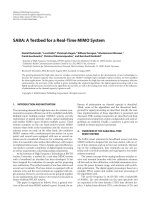Internet based real time communication system
Bạn đang xem bản rút gọn của tài liệu. Xem và tải ngay bản đầy đủ của tài liệu tại đây (2.72 MB, 146 trang )
INTERNET-BASED REAL-TIME
COMMUNICATION SYSTEM
TOK MENG YONG
(B.Eng.(Hons.), NUS)
A THESIS SUBMITTED
FOR THE DEGREE OF MASTER OF ENGINEERING
DEPARTMENT OF ELECTRICAL AND COMPUTER ENGINEERING
NATIONAL UNIVERSITY OF SINGAPORE
2004
A CKNOWLEDGMENTS
I would like to thank my supervisors, Associate Professor Ge Shuzhi Sam and
Professor Lee Tong Heng for giving me the opportunity to carry out research and
development work under the Master of Engineering program. During my stint as a
research scholar, I have acquired valuable skills and knowledge, particularly those
pertaining to carrying out effective research.
The research program is indeed enriching. The exposure and experience I gained will
definitely benefit me in my career in the future.
i
C ONTENTS
Acknowledgments
Contents
List of Figures
List of Tables
Summary
1.
2.
3.
4.
5.
i
ii
v
viii
ix
Introduction
1
1.1. Synchronous Communication
1.2. Project Objectives
1.3. Organization of Thesis
1
2
3
Data Transmission Technologies
6
2.1. Modes of Data Transmission over IP
2.2. Multicast
2.2.1. Multicast Taxonomy
2.2.2. IP Multicast
2.2.3. IP Multicast Addresses
2.3. Drawbacks of IP Multicast
6
8
8
10
10
11
System Overview
14
3.1. System Entities
3.2. System Initialization
3.3. System Operation
15
16
17
Data Structures and Algorithms
21
4.1. Data Access in Computer Systems
4.1.1. Memory Swapping and Paging
4.1.2. Locality of References
4.2. Conventional and Modified Array Structures
4.3. Buffer Arrays
4.3.1. Circular Array
4.3.2. General Circular Buffer
4.4. Sorted Arrays
4.4.1. Repeated-Item Sorted Array
4.4.2. Segmented-Sequence Sorted Array
4.5. Recyclable Array
21
21
22
23
25
25
26
28
30
31
32
Cryptographic Implementations
34
5.1. Random Sequence Generation
5.2. Cryptographic Service Provider
5.3. Security Considerations
5.3.1. Network-based Attacks
5.3.2. System-based Attacks
34
35
37
37
38
ii
6.
7.
8.
5.4. Security Measures
5.4.1. User Authentication
5.4.2. Secure Communication
5.4.3. Key Distribution
5.4.4. Key Storage
5.4.5. Key Recovery
38
38
43
44
45
47
Communication Protocol
49
6.1.
6.2.
6.3.
6.4.
6.5.
6.6.
6.7.
6.8.
6.9.
Packet Structure
Entity Discovery
User Directory Management
Handshaking
Time Synchronization
Session Membership Management
Session Key Export
User Management
Session Communication
6.9.1. Presence Information Notification
6.9.2. Session Invitation
6.9.3. Text Communication
6.9.4. Audio Communication
6.9.5. Data File Transfer
6.10. Transcript Repository Management
6.10.1. Session Information Update
6.10.2. Session Migration
6.10.3. Key Update
6.11. Gateway Management
49
51
53
55
57
59
63
65
66
66
69
71
73
74
77
77
78
80
81
System Database
86
7.1.
7.2.
7.3.
7.4.
86
87
89
91
Transcript Repository
8.1.
8.2.
8.3.
8.4.
8.5.
8.6.
9.
Organization of Tables
User Record Administration
Query Execution
New Account User Notification
94
Structure of Transcript Repository
Caching of Text Messages
Transcript Search
Transcript Reconstruction
Session Migration
Session Recovery
95
96
97
100
101
101
Messaging Gateway
103
9.1.
9.2.
9.3.
9.4.
104
104
106
107
Organization of Sub-networks and Gateways
Gateway Initialization
UDP Tunneling
Gateway Load-Balancing
iii
10.
11.
12.
Messaging Server
109
10.1.
10.2.
10.3.
10.4.
10.5.
10.6.
10.7.
111
111
112
113
115
116
118
User Authentication
Time Synchronization
User Directory Service
Session Parameters Allocation
Session Membership Management
Session Key Distribution
Gateway Management
Messaging Client
120
11.1.
11.2.
11.3.
11.4.
11.5.
11.6.
11.7.
120
121
123
124
125
126
130
User Access Control
Session Creation
Session Invitation
Text Communication
Audio Communication
Data File Transfer
Presence Status Broadcast
Conclusion
131
References
134
iv
L IST OF F IGURES
Figure 2.1. Comparison of data transmission modes in a one-to-many scenario
7
Figure 2.2. Rooted and non-rooted control planes
9
Figure 2.3. Rooted and non-rooted data planes
9
Figure 3.1. System layout
14
Figure 3.2. System operation
17
Figure 4.1. Conventional array structures
23
Figure 4.2. Operation of circular array (FIFO configuration)
26
Figure 4.3. Insertion into general circular buffer
27
Figure 4.4. Insertion into sorted array
29
Figure 4.5. Structure of repeated-item sorted array
30
Figure 4.6. Structure of segmented-sequence sorted array
31
Figure 4.7. Sequential insertion into recyclable array
32
Figure 4.8. Updating index arrays within recyclable array
33
Figure 4.9. Reusing inactive slots in recyclable array
33
Figure 5.1. 8-phase handshake
39
Figure 5.2. Exchange key database
45
Figure 5.3. Session key database
46
Figure 6.1. General header structure
49
Figure 6.2. Sub-header structure for entity discovery
52
Figure 6.3. Sub-header structure for user directory management
54
Figure 6.4. Sub-header structure for handshaking
56
Figure 6.5. BLOB header structure for handshaking operation payload
56
v
Figure 6.6. Sub-header structure for time synchronization
58
Figure 6.7. Structure of TimeSyncInfo
58
Figure 6.8. Structure of SessionParamEx
59
Figure 6.9. Structure of sub-header for session membership management
61
Figure 6.10. Structure of sub-header for session key export
63
Figure 6.11. Structure of sub-header for user management
65
Figure 6.12. Structure of sub-header for presence information notification
67
Figure 6.13. Structure of sub-header for session invitation
69
Figure 6.14. Structure of sub-header for text communication
71
Figure 6.15. Structure of sub-header for audio communication
73
Figure 6.16. Structure of sub-header for data file transfer
75
Figure 6.17. Structure of sub-header for session information update
77
Figure 6.18. Structure of sub-header for session migration
79
Figure 6.19. Structure of sub-header for key update
80
Figure 6.20. Structure of sub-header for gateway management
82
Figure 6.21. Structure of gateway loading report
84
Figure 7.1. Database administrator activation wizard
87
Figure 7.2. GUI for user records administration
88
Figure 7.3. GUIs for user record data entry
88
Figure 7.4. GUI for database query execution
90
Figure 7.5. Display for database query results
90
Figure 7.6. General settings for new user account notification
91
Figure 7.7. SMTP and e-mail settings for new account notification
92
Figure 7.8. Printout settings for new account notification
93
Figure 8.1. Transcript repository activation wizard
94
vi
Figure 8.2. Pass-phrase for transcript repository activation
95
Figure 8.3. Transcript search features within transcript repository
98
Figure 8.4. Search operation based on user’s screen name
99
Figure 8.5. Transcript search results
99
Figure 8.6. Structure of STF
100
Figure 9.1. Gateway activation wizard
103
Figure 9.2. Organization of sub-networks and gateways
104
Figure 9.3. Gateway status display
105
Figure 9.4. UDP tunneling
106
Figure 10.1. Messaging server activation wizard
109
Figure 10.2. Connection establishment of messaging server with system entities
110
Figure 10.3. Customization of exclusion list for session parameters allocation
114
Figure 10.4. Session information retrieval
116
Figure 11.1. GUI for user login
120
Figure 11.2. New session creation
121
Figure 11.3. GUI for session communication
122
Figure 11.4. Session invitation
123
Figure 11.5. Invitation card
123
Figure 11.6. GUI for text communication
124
Figure 11.7. GUI for audio communication
125
Figure 11.8. File transfer initialization report
127
Figure 11.9. File transfer delivery report
129
vii
L IST OF TABLES
Table 2.1. IP multicast addresses
10
Table 5.1. Cipher algorithms accessible from the CSP
36
Table 5.2. Message digest algorithms accessible from the CSP
37
Table 11.1. Presence statuses and their associated icons
viii
130
S UMMARY
This thesis describes the development of a network-based real-time group
communication system. Unlike conventional Instant Messaging systems, which are
well known for their abilities to handle one-to-one communication on the fly, this
system shall focus mainly on many-to-many communication. In this respect, a user is
able to initiate and/or participate in multiple concurrent communication sessions, each
comprising of many users.
IP multicast techniques are used in this system. In contrast to unicast, multicast allows
the same data to be sent simultaneously to all intended recipients without having to
repeat the transmission for each user in the list of recipients. In the context of a group
communication system, this inherent characteristic of multicast improves bandwidth
efficiency, timeliness of response and provides a straightforward means of managing
session membership.
The communication system that is developed consists of a messaging server, a
database server, a database administrator module, a transcript repository, messaging
gateways and messaging clients.
The messaging server oversees the operation of the system and is responsible for user
authentication, time synchronization, encryption key distribution and session
management. To ensure privacy of communication between a user and the messaging
server, a set of exchange keys is established using an 8-phase handshake procedure.
This set of exchange keys will be subsequently used for the encryption of privileged
ix
content, such as the encryption keys for session communication, while they are
transmitted from the messaging server to the user.
The database administrator module serves as an interface to an underlying database
server and provides access to the user records for the system. Using the database
administrator module, insertion, deletion and update of user records can be carried out
without having to execute any complicated database commands. In addition, the
administrator module also allows the customization of the ways in which new users are
notified of their account information.
For accountability reasons, the transcript repository is designed to store all text
messages that are exchanged among the participants in each session. All text messages
are encrypted to protect the potentially sensitive data within the messages. To allow
text messages to be efficiently retrieved for inspection, a search scheme that is based
on the use of descriptor files is implemented.
The messaging client provides access to the communication functionalities of the
system. Upon successful authentication, a user can create or join existing sessions and
engage in text/audio-based communication. A multicast-based file transfer feature is
also available for supporting the mass-transmission of files to multiple recipients.
Under most network security policies, the corporate network is segmented into zones
of varying trust levels. Due to the potential threats that multicast pose to the network
when it is used for nefarious purposes, multicast traffic is often prevented from
propagating beyond the boundary of each zone. For this reason, messaging gateways
are created to identify the multicast groups that are associated with each
communication sessions and link them if they straddle different trust zones.
x
CHAPTER 1
INTRODUCTION
Over the past decade, the rate at which existing network technologies are displaced by
newer ones is indeed alarming. With the ubiquitous deployment of Local Area
Networks (LANs) within corporations and institutions, synchronous modes of
communication are now creeping into some of the roles that were once fulfilled by
asynchronous means.
1.1.
Synchronous Communication
As the mainstay of electronic communication, e-mail, being asynchronous in nature, is
gradually losing its charm as the communication mode of choice among people who
are geographically separated. At the same time, Instant Messaging (IM) systems as
described in [1], [2], [3] have evolved from being a teenage fad to a productivity tool.
Coordination and collaboration can now take place via real-time text/audio/video.
The use of IM services offered by companies such as Microsoft, Yahoo and AOL is
now a common sight at the workplace as business leaders realize its potential as a
collaborative tool. However, conventional IM systems are not developed with group
communication [4] in mind and thus, have some serious drawbacks when used within
in the context of businesses and institutions. Among these are the problems of resource
utilization, timeliness of response, security and accountability.
Although conventional IM systems excel in facilitating one-to-one communication,
they do not scale well. While this may not be a serious problem in a session that
1
involve only a handful of participants, network congestion and the corresponding
increase in response time become apparent when the number of participants becomes
large. The result can be particularly annoying when users communicate in audio/video
modes, which require a large amount of bandwidth. As such, support for large-scale
group communication is often not available in these systems.
Security features, such as data encryption, are usually not present in conventional IM
systems. As such, when the content of communication sessions are transported across
networks over unprotected channels, they are exposed to prying eyes and can be easily
extracted using available network sniffing applications. At the same time, conventional
IM systems also lack accountability features for monitoring compliance with corporate
policies on information disclosure.
In order to overcome these problems, an IM system based on a new data delivery
mechanism must be developed. The data transfer mode must allow the system to scale
well in the face of dynamically changing session group size. At the same time, security
and accountability features must also be incorporated into the new system.
1.2.
Project Objectives
The main objectives of this project are as follow:
•
Development of a multicast-based real-time group communication system
•
Development of a secure storage area for communication transcripts
•
Implementation of a set of communication protocol for controlling system
entities and transferring data among these entities
2
•
Creation of an efficient management system for handling the allocation and
recycling of multicast group parameters
•
Development of a cryptographic scheme for securing communication channels
•
Creation of gateways for connecting trusted and untrusted sub-networks
•
Development of an assurance scheme for addressing flow control issues related
to the use of UDP
1.3.
Organization of Thesis
This thesis describes the research and development work behind the Rhapsody project.
In this project, a multicast-based secure IM system is developed from scratch, with
special emphasis on addressing the drawbacks of conventional IM systems. Besides
supporting real-time communication in text/audio/data modes, the Rhapsody
Messaging System also provides a scalable solution to group communication needs in
a corporate environment.
In Chapter 2, a survey of the various common forms of data transmission over Internet
Protocol (IP)-based networks is carried out. This serves to provide a better
understanding of the motivation behind using multicast-based communication in the
Rhapsody Messaging System. In addition, the difficulties of a direct incorporation of
multicast techniques into such a system are also highlighted. These challenges define
the scope of the research and development work that need to be carried out in this
project.
3
In Chapter 3, an overview of the Rhapsody Messaging System is provided. Besides
offering an introduction to the entities that make up the system, a general description
of the system operation is also given.
In Chapter 4, a discussion on the data structures and algorithms that are used for
improving system scalability and efficiency is presented. These data structures are
developed based on the fusion of computer memory access theories with mathematical
routines.
A description of the security implementation adopted by the system is provided in
Chapter 5. This includes a description of the 8-phase handshake procedure, which is a
cornerstone of the key exchange policy used for user authentication and key
distribution.
In view of the myriad of activities within the system, great care must be taken in the
design and implementation of a set of network protocol for controlling and
coordinating the various system entities. This protocol is presented in Chapter 6.
The system database, which consists of the administrator module and the underlying
database engine, is described in Chapter 7. Emphasis will be placed on the operation of
the database administrator and its role in notifying new users of their account
information.
In Chapter 8, the operation of the transcript repository is described. The transcript
repository caches the encrypted content of session communication in real-time and
provides search functionalities for encrypted transcripts.
The operation of the messaging gateway is described in Chapter 9. The messaging
gateway is an optional part of the system and is only required when the network
4
security policy prevents multicast traffic from propagating across logical subnetworks.
The messaging server is described in Chapter 10. In this chapter, issues concerning
user authentication, time synchronization, session parameter allocation, session
membership management, session key distribution and gateway management are
discussed.
Chapter 11 describes the operation of the messaging client, with emphasis on the use
of the various communication features over secure channels.
Last but not least, a conclusion on the project execution is delivered in Chapter 12.
5
CHAPTER 2
D ATA T R A N S M I S S I O N
TECHNOLOGIES
Various forms of data transmission are supported in an IP network, each differing
mainly in terms of the size of their recipient group and their range of coverage.
Although all can be used in a group communication scenario, they are not equally
efficient in the utilization of processor time and network bandwidth.
For the Rhapsody Messaging System, communication is carried primarily using IP
multicast. To appreciate the merits of IP multicast over other available forms of data
transmission, it is important to first understand the underlying technologies for the
various methods of data delivery. The following sections provide a description of the
various types of data transfer, with special emphasis on IP multicast.
2.1.
Modes of Data Transmission over IP
Unicast, broadcast and multicast are 3 modes of data transfer that are supported by
Internet Protocol version 4 (IPv4) [5]. Each mode of data transfer differs in the way
data is replicated as it is sent from the source to the destination. Figure 2.1 illustrates
the difference between each of these data transmission modes when a host needs to
send the same data to multiple recipients within the network.
Unicast is inherently point-to-point with no replication of data during each
transmission. Using unicast, a node in the network shown in Figure 2.1 can only send
data to recipient nodes one at a time. The actual transfer of data involves only the
6
sender and the intended recipient nodes, and leaves the other nodes in the network
relatively undisturbed. This form of directed transfer offers a high level of control but
is susceptible to poor processor and network bandwidth utilization when the number of
recipients grows.
Unicast
Broadcast
Multicast
Figure 2.1. Comparison of data transmission modes in a one-to-many scenario
At the other end of the spectrum, data transfer carried out using broadcast causes the
data to be automatically replicated and sent to all nodes within the network. Unlike
unicast, which requires the sender node to carry out n individual transmissions for n
destination nodes, the underlying network support for broadcast allows data to be sent
to all nodes within the network in a single transmission. However, since not all nodes
in the network may be interested in receiving data from the sender, the indiscriminate
transmission of data tends to waste a considerable amount of processor time and
network bandwidth, especially when the actual target recipient group is small. The
adverse effect of broadcast transmission over IP networks on processor performance is
discussed in [6].
Multicast combines the best attributes of unicast and broadcast, allowing the directed
transfer of data to a target set of recipients in a one-to-many manner. Like broadcast,
7
data transfer in multicast is accomplished in a single transmission, regardless of the
number of destination nodes. However, unlike broadcast, the set of destination nodes is
configurable and can comprise of any number of nodes in the network. By ensuring
that only intended recipients are involved in the data transfer, multicast provides a
more efficient utilization of network bandwidth than unicast and broadcast.
2.2.
Multicast
Multicast is based on the concept of groups. A node must be a member of a multicast
group in order to receive data meant for the group. Different implementations of
multicast are available and they vary in terms of the way the control and data planes
are configured [7].
The control plane defines the way that multicast sessions are organized while the data
plane determines the manner in which data is transmitted among the member nodes of
a multicast session. Control and data planes can either be rooted or non-rooted.
2.2.1.
Multicast Taxonomy
In a rooted control plane, a special member node, called the c_root, must be present
throughout the session and is responsible for initiating session connections with the
rest of the session members, each of which is known as a c_leaf. In a non-rooted
control plane, each member node behaves like a c_leaf and session connections are
self-initiated. The difference in implementation between rooted and non-rooted control
planes is shown in Figure 2.2.
8
Rooted Control Plane
Non-rooted Control Plane
Figure 2.2. Rooted and non-rooted control planes
In a rooted data plane, a c_root node exists and is the centre of all data transfers. Data
transfer, whether uni-directional or bi-directional, must involve the c_root node. While
data from the c_root is sent to all c_leaf nodes, data from each c_leaf node can only be
sent to the c_root node. In a non-rooted data plane, all nodes are equal and data
transfer involves all member nodes. In this mode, it is also possible for member nodes
to receive data from a sender outside the group.
Rooted Data Plane
Non-rooted Data Plane
Figure 2.3. Rooted and non-rooted data planes
9
Figure 2.3 illustrates the difference between rooted and non-rooted data planes. For the
rooted data plane scheme, all c_leaf nodes will receive data “abc” sent by the c_root
node while the c_root node is the only node that can only receive data “xyz” from the
c_leaf node. In contrast, all member nodes in the multicast group under the non-rooted
data plane implementation will receive data “abc” and “xyz”.
2.2.2.
IP Multicast
IP multicast is a form of multipoint setup for IP networks in which both the control and
data planes are non-rooted. As such, multicast group membership is self-managed with
all member nodes having equal access to the transmitted data. IP multicast extends the
capabilities of conventional IP and the areas of extension are defined in the Internet
Engineering Task Force (IETF)-recommended standard, RFC 1112 [8].
2.2.3.
IP Multicast Addresses
In IP multicast, an address-port pair identifies an arbitrary group of IP nodes that have
joined a multicast session. The Internet Assigned Numbers Authority (IANA) controls
the assignment of addresses and has allocated the class D range of addresses (224.0.0.0
to 239.255.255.255) for multicast applications. Addresses within this range can be
further classified as link local addresses, globally scoped addresses and limited scope
addresses [9]. The range of each address group is shown in Table 2.1.
Table 2.1. IP multicast addresses
Multicast Address Type
Address Range
Link Local Address
224.0.0.0 – 224.0.0.255
Globally Scoped Address
224.0.1.0 – 238.255.255.255
Limited Scoped Address
239.0.0.0 – 239.255.255.255
10
Local link addresses are used by network protocols for automatic router discovery and
router communication. Multicast packets with addresses in this range will not be
forwarded by any router to an adjacent sub-network. Globally scoped addresses are
used for multicast transmission of data between Intranets and across the Internet.
Certain addresses within this range of globally scoped addresses are reserved by IANA
for use in protocols such as Network Time Protocol (NTP) [10]. Reserved globally
scoped addresses are defined in the IETF standard, STD 2 [11]. Last but not least,
limited scope addresses as defined in RFC 2365 [12], are constrained for use within an
Intranet.
2.3.
Drawbacks of IP Multicast
Although IP multicast is more suitable than alternative forms of data transmission for
group communication, it has its drawbacks and inadequacies.
Reliability
Among the 3 forms of data transmission described, only unicast is capable of
supporting both connection-oriented protocols such as Transmission Control Protocol
(TCP) and connectionless protocols such as User Datagram Protocol (UDP). Broadcast
and multicast can only support connectionless protocols, which implies a forfeiture of
useful features that includes error recovery, flow control and reliability. As a result,
data packets that are sent using IP multicast may arrive out of sequence at the
recipient’s end or even get lost in transmission.
Group Management
While the notion of group management does not apply to unicast and broadcast, it has
a significant bearing on the operation of multicast. As each multicast group is
associated with an address-port pair, it is important to prevent repetition in the
11
assignment of these network parameters. A combination that is currently in use should
not be assigned to a new group until it has been relinquished.
Security
As IP multicast is implemented based on non-rooted control and data planes, it is not
possible to prevent any uninvited node from joining a multicast group once the
address-port pair that identifies the group is known. At the same time, knowledge of
the address-port pair also allows a non-member node to send data to every member of
the group. Hence, security measures must be implemented to block out unwanted
traffic and ensure that access to transmitted data is only restricted to legitimate
members of the group.
Network Security Policy Restriction
In most organizations, users belonging to different domains are assigned to different
logical sub-networks within the physical network. Each domain conforms to a different
security scheme for accessing network resources. For example, a user who logs in as
an unauthenticated local user may be logically assigned to an untrusted sub-network.
Users in untrusted sub-networks have lower access rights than users belonging to
trusted domains, and may be barred from accessing certain shared resources on the
Intranet. Since IP multicast is non-rooted in the control and data planes, it can be a
potential security hazard in a network that comprises of both trusted and untrusted subnetworks. Thus, it is a common practice in network security implementations to
prevent multicast traffic from propagating across the logical sub-networks. In the
presence of these network security measures, it is necessary to implement some form
of tunneling to connect the trusted and untrusted sub-networks when multicast
applications are to be used for non-nefarious purposes.
12
System Complexity
In view of the above-mentioned considerations, it is clear that the amount of effort
required to implement a multicast-based communication system is not trivial. With the
need to devise and incorporate ways for overcoming each of the problem areas, the
complexity of the entire system will inevitably be higher than that of a conventional
system; and managing a complex system is by itself another challenge.
13
CHAPTER 3
S Y S T E M O V E RV I E W
The Rhapsody Messaging System is built on a server/client architecture with the
system core comprising of a messaging server, a database server and a transcript
repository. Figure 3.1 shows the general layout of the system. To facilitate data entry, a
database administrator module is set up to act as an interface to the database server.
Depending on the nature of the network security policy that is implemented, this setup
may be further supported by a set of gateways for connecting multicast groups that
straddle multiple logical sub-networks. Messaging clients are distributed throughout
the network and each is able to make use of the system setup to engage in group-based
communication.
Figure 3.1. System layout
14









